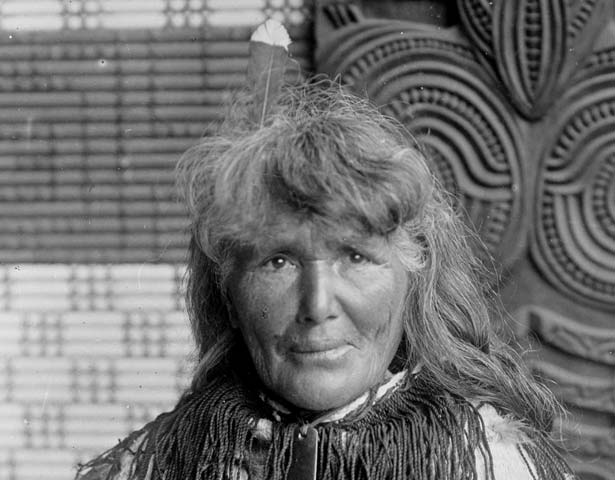
Best known as ‘Guide Sophia’ (but sometimes also as Te Paea or Tepaea), Hinerangi was the principal tourist guide of the famous Pink and White Terraces at Lake Rotomahana. Following their destruction during the Mt Tarawera eruption of 1886, she became a tour guide at nearby Whakarewarewa, Rotorua.
Sophia was born in Kororāreka in the early 1830s. Her mother, Kotiro Hinerangi, was a Ngāti Ruanui woman who had possibly been captured by a Nga Puhi raiding party. Kōtiro married Alexander Grey (or Gray), a Scotsman who had arrived in the Bay of Islands in 1827. Mary Sophia Gray was baptised by William Williams at Kororareka in 1839. It is claimed that Sophia was raised by Charlotte Kemp at the Kerikeri mission station before attending the Wesleyan Native Institution at Three Kings in Auckland.
In 1851 Sophia married her first husband, Koroneho (Colenso) Tehakiroe, with whom it is said she had 14 children. Following her second marriage, to Hori Taiawhio in 1870, she had a further three children. Living at Te Wairoa on the shores of Lake Tarawera, Sophia became a renowned guide to the world famous Pink and White Terraces.
Attractive, well educated and bilingual, Guide Sophia established a reputation as 'guide, philosopher, and friend' to thousands of tourists. Eleven days before the 1886 eruption she was leading a tour group when suddenly the lake level fell, then rose again. This phenomenon was accompanied by an ‘eerie whimpering sound’. Shortly afterwards, a phantom canoe appeared with a sole paddler. The canoe grew bigger as it approached the tourists and by now boasted a crew of 13, each of whom had a dog's head. The ghostly waka then shrank and disappeared. Tuhoto Ariki, a Tuhourangi tohunga, interpreted this as a warning; the exploitation of the terraces as a tourist attraction showed no regard to ancestral values. Guide Sophia herself saw these omens as a sign that her time as a guide at Rotomahana was near an end.
On 10 June 1886, the night of the eruption, over 60 people took shelter in Sophia’s whare at Te Wairoa. Unlike many of the buildings in the village her home withstood the destructive power of the eruption due to its high-pitched roof and strong reinforced timber walls. Tuhoto Ariki also survived the eruption and was dug from his buried house four days later.
Sophia continued her guiding work when she moved to nearby Whakarewarewa. In 1895 she joined George Leitch's Land of the Moa Dramatic Company, playing herself on a tour of Australia. In 1896 she was appointed caretaker of the Whakarewarewa thermal reserve. A number of royal parties were amongst the many that Guide Sophia led through Whakarewarewa. She encouraged a number of local women to become guides, helping to establish this occupation as a lucrative form of employment for Tuhourangi women.
Sophia was also heavily involved in the New Zealand Women's Christian Temperance Union, becoming president of the Whakarewarewa branch in 1896.
Guide Sophia died at Whakarewarewa on 4 December 1911.
Adapted from the DNZB biography by Jenifer Curnow
How to cite this page
'Sophia Hinerangi (Guide Sophia)', URL: https://nzhistory.govt.nz/people/guide-sophia, (Ministry for Culture and Heritage), updated 21-Mar-2023

Community contributions